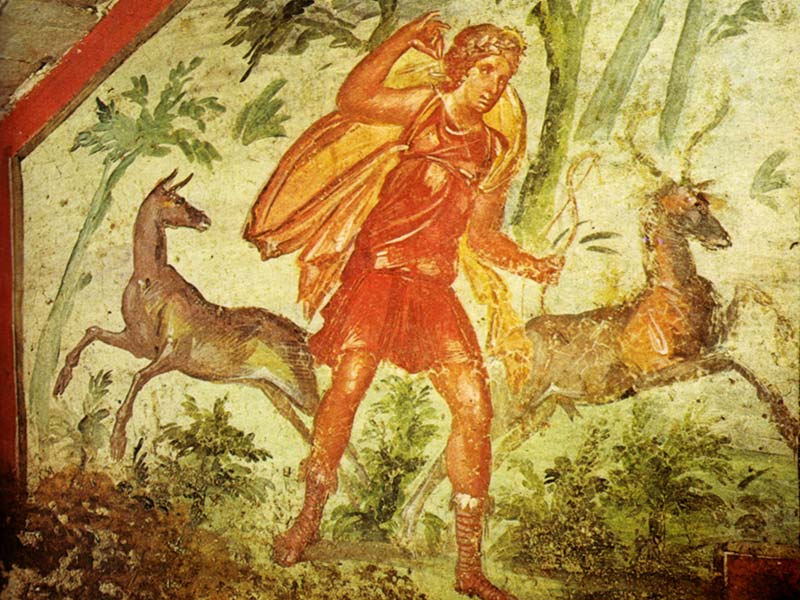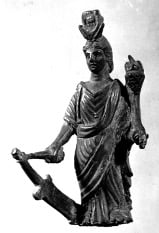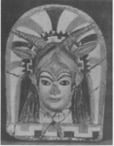di Sarah Perini
Adapted from Marija Gimbutas - Twenty years of Goddess study - Proceedings of the conference of the same name – Rome 9-10 May 2014 – Laima Editorial Project – Turin
Fortuna
She is the protector of human fertility and childbirth, the one who happily brings the pregnancy to term, the one who is rich, fertile, pregnant, the giver of gifts, often represented with a cornucopia full of flowers and fruit. The Mother Goddess supporting or squeezing her breasts or holding her children to her breast; virgin in the meaning of free from constraints that she mates freely choosing her mates (Fortuna, Acca Larentia and Flora were also known to have chosen Roman princes as lovers).
In the area of Lazio and Etruria, inhabited since ancient times by autochthonous populations and endowed with common characteristics, we find images of Fortuna portrayed in sculpted or wooden figures holding up a child or in animal forms, trees or columns placed inside a sacred space, said saccellum, obtained with leaves or wood, often inside a sacred clearing, a typically Italian place.
Bona Goddess
Bona Dea is Lady of herbs and animals and protector of the health of mothers and offspring.
The cult area was typically Italic as it was built with a small boundary wall that delimited a grove, with a source inside, an aedicule for the image of the Goddess and a hut. The main characteristics of Bona Dea's cult are: the presence of snakes in her temple; the presence of the paredro Faunus which can often be transformed into a snake, emphasizing the union between the female divinity and the chthonic and phallic animal par excellence; the use of wine as a ritual drink, a typical feature of the peoples of Italy and Lazio; the presence in the sacred place of a herbarium, a garden of healing herbs, cultivated by the priestesses of the Goddess and protected by her.
Mother Matuta
Mater Matuta next to Bona Dea is "the Good Mother" the Divine Mother who watches over the lives of women, promotes fertility, guides births, watches over creatures, guarantees the life of animals, vegetation and the agricultural community. Mater Matuta is "the Mother of the Morning Hour", the first light that creatures see coming out of the maternal womb.
The cult of this Goddess blossomed simultaneously and independently in Umbria, Etruria, Lazio and Campania, as a consequence of the ethnic and cultural unity of the Mediterranean populations of the area alongside other deities such as Diana, Feronia, Juno, Marica. Terracotta votive offerings representing fruit, flowers, animals and parts of the body have been found in sacred places to indicate the protective and healing functions of Mater Matuta.
Domestic or domesticated animals appear more in this phase and indicate how the characteristics and functions of the original wild Mediterranean Goddess are adapting to the reality of agricultural communities. We see dogs, horses, oxen, sheep, roosters, doves, pigs, boars, fish appear. Among the offers we also find bread and focaccia.
Among the votive terracotta body parts appear: breasts, arms, legs, feet, eyes, masks, figurines of children and even paws of animals.
Feronia
She is the Lady of the Fairs, of wild animal life, of plants and medicinal herbs, she preserves all the characteristics of the ancient Mediterranean Potnia intact. The root fero also indicates "the pregnant woman" therefore has the usual protective functions of the maternal.
Feronia is a Virgo Sacra, a Virgin Goddess not subject to marriage bonds, but accompanied by her paredro Picus, the sacred woodpecker, bearer of celestial fire connected to the fertilizing energy, but also a wise connoisseur of the places where some healing plants grow; we will also find it next to the Goddess Diana.
Diana
As the last but most important Italian Goddess, Marconi describes Diana, very widespread and with specific characteristics, an articulated cult, equipped with cultic assistants such as priestesses, nymphs and paredri.
The cult of Diana is essentially sylvan; she is defined Queen of the Sacred Wood, Diana Lucina – Goddess of the clear place in the wood, the sacred clearing primordial abode of divinity; Goddess Lucifer of the flame of the torches that illuminate the sacred wood and the animal and vegetable creatures that she protects in the night; Goddess of apotropaic and purifying fire; Lady of the Lake; Lady of sacred trees, standing stones, pillars and sacred enclosures; Goddess of woods, forests, mountains, lakes, rivers, medicinal plants; later she is associated, like Bona Dea, also with the goddess Dia, protector of grain, cultivated fields and farmed animals.
Diana protector of fertility, motherhood and couples, of human and animal births and of water births; her nymphs, such as the Nymph Egeria, and her priestesses guided the women in the stages of childbirth. It also brings healing through sacred herbs.
Diana is belatedly associated with the goddess Luna who is however a separate divinity, like Artemis is associated with Selene, but both are originally terrestrial and non-celestial divinities.
His sacred animals are: the deer, the white doe, wild goats, horse, dog, dove, aquatic birds, woodpecker, wild boars, pigs, fish and fairs.
Sacred plants: peony and artemisia (healing herbs that promote childbirth), lily, laurel, medicinal herbs, palm, oak, apple tree, bunches of grapes.
Symbols connected to it: stele, pillars, columns, poles, trees, torches, festoons of flowers and fruit and ribbons, branches, flowering sceptres, cow and deer horns.
His parents are Virbio the "young green man" (from the root urbos derive rod and verbena, the branch and the sacred herb) and Silvano “the silvestre man”, adult or elderly, both keepers of the horses of the Goddess; Picus “the woodpecker man” also appears, connoisseur of healthy herbs and the secret place of peonies.
The Goddess holds the life, death and resurrection of her companion in her hand, when he dies she resurrects him with the water of life and the healthy herbs of her secret garden (as happens for all the other great Mediterranean goddesses, Isthar , Astarte, Kybele, Isis).
Diana wears a short dress, a flounced skirt and is represented while running, riding, shooting with a bow, sometimes naked or veiled with the torch in her hand, young, agile and powerful girl, almost never bejeweled, sometimes crowned.
It appears armed with bow, arrows, quiver, spears, bells, as well as the Mediterranean Potnia, more to defend the creatures of the wood than to hunt them.
Sarah Perini
Adapted from Marija Gimbutas - Twenty years of Goddess study - Proceedings of the conference of the same name – Rome 9-10 May 2014 – Laima Editorial Project – Turin







